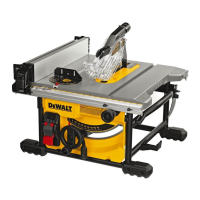12
ENGLISH
1. Raise the saw blade arbour to its maximum height by
turning the blade height adjustment wheel
6
clockwise.
2. Remove the throat plate
15
. Refer to Mounting the
ThroatPlate.
3. Using wrenches
19
, loosen and remove the arbour nut
26
and clamp washer
27
from the saw arbour by turning anti-
clockwise.
4. Place the saw blade on to the arbour
28
making sure the
teeth of the blade
2
point down at the front of the table.
Assemble the washers and arbour nut to the spindle and
tighten arbour nut
26
as far as possible by hand, making
sure that the saw blade is against the inner washer and the
outer clamp washer
27
is against the blade. Ensure the
largest diameter of the flange is against the blade. Ensure
the spindle and washers are free from dust anddebris.
5. To keep the spindle from rotating when tightening the
arbour nut, use the open end of the blade wrench
19
to
secure thespindle.
6. Using the closed end of the blade wrench, tighten the
arbour nut
26
firmly by turning itclockwise.
7. Replace the throatplate.
WARNING: Always check the rip fence pointer and the
blade guard assembly after having changed theblade.
Mounting/Removing the Blade Guard
Assembly/Riving Knife (Fig. A, C)
WARNING: Use the guard assembly for all
throughcutting.
1. Raise the saw blade arbour to its maximumheight.
2. Loosen the riving knife lock knob
29
(minimum of
threeturns).
3. To disengage riving knife lock pin, pull lock knob as
indicated by the black arrows on theknob.
4. While pulling the lock knob, lift the riving knife out of the
clamp. Then slide the blade guard assembly
11
into the
clamp until it bottomsout.
NOTE: Do not install both blade guard assembly and riving
knife into the clamp at the sametime.
5. Release the lock knob to engage the lock pin. Give the blade
guard a slight pull upwards to ensure pin isengaged.
6. Tighten the riving knife lockknob.
NOTE: Follow the same procedure for the rivingknife.
WARNING: Before connecting the table saw to the power
source or operating the saw, always inspect the blade
guard assembly for proper alignment and clearance
with saw blade. Check alignment after each change of
bevelangle.
WARNING: To reduce the risk of serious personal injury,
DO NOT operate saw if blade assembly is not securely
clamped inplace.
When properly aligned, the riving knife
21
will be in line with
the blade at both table top level, and at the top of the blade.
Using a straight edge, ensure that the blade
2
is aligned with
the riving knife
21
. With power disconnected, operate the
blade tilt and height adjustments through the extremes of
travel and insure the blade guard assembly clears the blade in
alloperations.
WARNING: Correct mounting and alignment of the blade
guard assembly is essential to safeoperation!
Mounting the Throat Plate (Fig. D)
1. Align the throat plate
15
as shown in FigureD, and insert
the tabs on the back of the throat plate into the holes on the
back of the tableopening.
2. Turn the locking screw
30
with a screw driver clockwise 90°
to lock the table insert inplace.
3. The throat plate includes four adjustment screws which
raise or lower the throat plate. When properly adjusted, the
front of the throat plate should be flush or slightly below the
surface of the table top and secured in place. The rear of the
throat plate should be flush or slightly above the tabletop.
WARNING: Never use the machine without the throat
plate. Immediately replace the throatplate when worn
ordamaged.
Removing the Throat Plate
1. Remove the throat plate
15
by turning the locking
screw
30
with a screw driver 90˚ anti-clockwise
2. Pull throat plate up and forward to expose the inside of the
saw. DO NOT operate the saw without the throatplate.
Fitting the Rip Fence (Fig. E)
The rip fence can be installed in two positions on the right
(Position 1
47
for 0mm to 510mm ripping, and Position2
47
for 100mm to 610mm ripping.) and one position on the left of
your tablesaw.
1. Unlock the rip fence latches
17
.
2. Holding the fence at an angle, align the locator pins
47
(front and back) on the fence rails with the fence head
slots
31
.
3. Slide the head slots onto the pins and rotate the fence down
until it rests on therails.
4. Lock the fence in place by closing the front and back
latches
17
onto therails.
Fixing to Workbench (Fig. A)
• The machine frame between the feet on each side is
provided with two holes
9
which allow fixing on a
workbench. Use the holesdiagonally.
• To improve the handling, fix the machine onto a piece of
plywood a minimum of 15 mmthick.
When in use, the plywood sheet can be clamped to the
workbench. This allows easier transportation of the machine, by
releasing theclamps.
Holes
24
are also provided under under the saw feet for
mounting to DE7400brackets.

